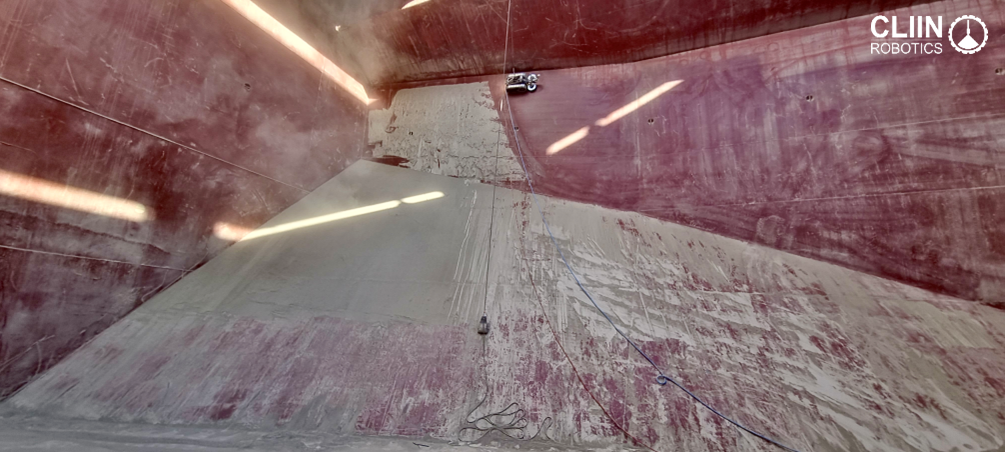For shipowners, service providers and operators, the business of bulk cargo is a relentless balance of minimizing costs and maximizing revenue. Every hour spent in port represents lost revenue and has a direct impact on the bottom line.
No task embodies this challenge more than the post-voyage cleaning of cargo holds, particularly after carrying demanding commodities like cement and clinker. By removing potential contaminants and creating a clean, dry environment suitable for the next cargo, the cleaning process is critical.
Traditional and manual cleaning methods are often labor-intensive, hazardous, and time-consuming, making them an unnecessary expense. Cargo hold cleaning is also crucial for maintaining the integrity and extending the lifetime of internal cargo hold coatings.
The Robotic Shift in Maritime Business
The Cargo Hold Robot, produced and developed by the Danish company CLIIN Robotics, transforms cargo hold cleaning by drastically reducing the necessity for people to perform manual cleaning in inherently hazardous work areas. This significantly reduces the risk of accidents, improves the overall working environment, and consequently reduces costs.
The Cargo Hold Robot (CHR) decreases cleaning time by up to 50% compared to traditional multi-step cleaning methods that require a large team of workers. This results in faster vessel turnaround times, maximizing laden days, and improving profitability for shipping companies.
The robot's ability to clean even while the ship is sailing (with hatches closed) further boosts operational efficiency.
Cleaning Cement Faster, Safer, and Cheaper
Continuous development in collaboration with customers is a cornerstone of CLIIN Robotics' strategy.
The challenge of cleaning hardened cement and clinker required CLIIN Robotics to develop a specialized dry brush tool. This tool is easily attached to the robot via the switch-system on top of the robot.
The critical issue with cement residue is that using water or other liquid-based substances for cleaning will result in solid rock deposits instead of a clean hold. By attaching a specially designed dry brush tool for cement to the robot, it efficiently removes the hardened cement and clinker residue from the cargo hold surfaces.
The CLIIN dry Cement Cleaning Tool is more than just a piece of equipment; it's a solution to the most critical operational challenges in the bulk shipping sector.

The innovative brush tool with four brushes and a pressure reduction valve is engineered for effective dry cleaning. This system also minimizes dust, ensuring a safer and dust-reduced environment, thus safeguarding the well-being of workers.
The robot is controlled easily by a remote joystick, allowing safe operation from the ground, minimizing exposure to harmful cement dust. Additionally, the cleaning operation reduces the need for cherry pickers and minimizes the number of personnel involved.
CLIIN Robotics is currently the only company worldwide to offer dry cleaning of cement by a brush tool on a robot.
Maximizing Earning Potential and Protecting Assets
The dry-cleaning process dramatically reduces the time a vessel needs to spend in port for cleaning, enabling a quick turnaround. This not only saves on labor costs but, more importantly, allows the ship to return to service faster, directly increasing its earning potential.
The cost efficiency of this technology extends beyond just labor. Traditional methods require expensive and corrosive chemicals, which degrade the protective paint coatings in cargo holds. The CLIIN's dry-brush, chemical-free process actively protects these coatings, extending their lifespan and reducing long-term maintenance costs. By simplifying a complex task and requiring a smaller crew, the robot directly lowers operational expenses and reduces the impact on the environment.
Dry Cleaning in Singapore
Cement and clinker are particularly difficult to handle. When moisture infiltrates a cargo hold, the fine dust transforms into concrete-like deposits that adhere to every surface. If not removed promptly, these residues can cause permanent structural damage.
The recent contract award in the Singapore harbor is a powerful testament to the robot's effectiveness.
The Cargo Hold Robot (CHR) is easy to operate by the vessel's crew, requiring minimal training. This empowers crews to manage cleaning operations in-house, reducing reliance on external cleaning contractors and further driving down operational costs.
Singapore is one of the world's busiest ports, and a successful dry cleaning of a cement cargo hold there demonstrates the robot's ability to perform in high-stakes environments and to deliver on its promise of efficiency, safety and reliability.
Moving into the future
The maritime industry is facing increasing demands for safety and environmental protocols, and CLIIN's technology addresses both. Ultimately, the choice to adopt robotics like CLIIN's comes down to a clear value proposition.
By automating cargo hull cleaning, maritime shipowners, service providers and operators are seeing significant reductions in downtime, labor costs, and exposure to hazardous chemicals when cleaning.
The consistent, high-quality cleaning directly translates to better adherence to environmental regulations and improved vessel performance. For an industry facing razor-thin margins, these robot solutions a competitive necessity for maintaining profitability and compliance.
